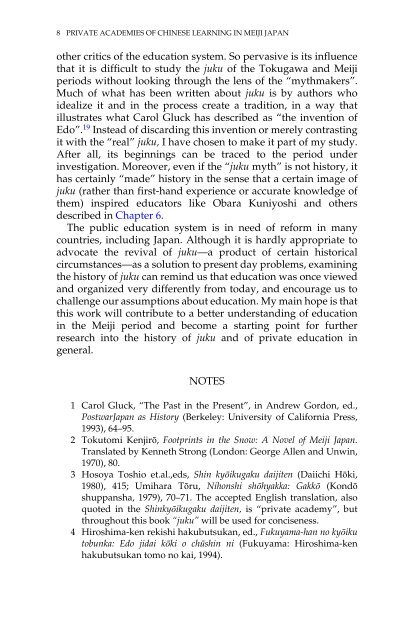Private Academies of Chinese Learning in Meiji Japan: The Decline ...
Private Academies of Chinese Learning in Meiji Japan: The Decline ...
Private Academies of Chinese Learning in Meiji Japan: The Decline ...
You also want an ePaper? Increase the reach of your titles
YUMPU automatically turns print PDFs into web optimized ePapers that Google loves.
8 PRIVATE ACADEMIES OF CHINESE LEARNING IN MEIJI JAPANother critics <strong>of</strong> the education system. So pervasive is its <strong>in</strong>fluencethat it is difficult to study the juku <strong>of</strong> the Tokugawa and <strong>Meiji</strong>periods without look<strong>in</strong>g through the lens <strong>of</strong> the “mythmakers”.Much <strong>of</strong> what has been written about juku is by authors whoidealize it and <strong>in</strong> the process create a tradition, <strong>in</strong> a way thatillustrates what Carol Gluck has described as “the <strong>in</strong>vention <strong>of</strong>Edo”. 19 Instead <strong>of</strong> discard<strong>in</strong>g this <strong>in</strong>vention or merely contrast<strong>in</strong>git with the “real” juku, I have chosen to make it part <strong>of</strong> my study.After all, its beg<strong>in</strong>n<strong>in</strong>gs can be traced to the period under<strong>in</strong>vestigation. Moreover, even if the “juku myth” is not history, ithas certa<strong>in</strong>ly “made” history <strong>in</strong> the sense that a certa<strong>in</strong> image <strong>of</strong>juku (rather than first-hand experience or accurate knowledge <strong>of</strong>them) <strong>in</strong>spired educators like Obara Kuniyoshi and othersdescribed <strong>in</strong> Chapter 6.<strong>The</strong> public education system is <strong>in</strong> need <strong>of</strong> reform <strong>in</strong> manycountries, <strong>in</strong>clud<strong>in</strong>g <strong>Japan</strong>. Although it is hardly appropriate toadvocate the revival <strong>of</strong> juku—a product <strong>of</strong> certa<strong>in</strong> historicalcircumstances—as a solution to present day problems, exam<strong>in</strong><strong>in</strong>gthe history <strong>of</strong> juku can rem<strong>in</strong>d us that education was once viewedand organized very differently from today, and encourage us tochallenge our assumptions about education. My ma<strong>in</strong> hope is thatthis work will contribute to a better understand<strong>in</strong>g <strong>of</strong> education<strong>in</strong> the <strong>Meiji</strong> period and become a start<strong>in</strong>g po<strong>in</strong>t for furtherresearch <strong>in</strong>to the history <strong>of</strong> juku and <strong>of</strong> private education <strong>in</strong>general.NOTES1 Carol Gluck, “<strong>The</strong> Past <strong>in</strong> the Present”, <strong>in</strong> Andrew Gordon, ed.,Postwar<strong>Japan</strong> as History (Berkeley: University <strong>of</strong> California Press,1993), 64–95.2 Tokutomi Kenjirō, Footpr<strong>in</strong>ts <strong>in</strong> the Snow: A Novel <strong>of</strong> <strong>Meiji</strong> <strong>Japan</strong>.Translated by Kenneth Strong (London: George Allen and Unw<strong>in</strong>,1970), 80.3 Hosoya Toshio et.al.,eds, Sh<strong>in</strong> kyōikugaku daijiten (Daiichi Hōki,1980), 415; Umihara Tōru, Nihonshi shōhyakka: Gakkō (Kondōshuppansha, 1979), 70–71. <strong>The</strong> accepted English translation, alsoquoted <strong>in</strong> the Sh<strong>in</strong>kyōikugaku daijiten, is “private academy”, butthroughout this book “juku” will be used for conciseness.4 Hiroshima-ken rekishi hakubutsukan, ed., Fukuyama-han no kyōikutobunka: Edo jidai kōki o chūsh<strong>in</strong> ni (Fukuyama: Hiroshima-kenhakubutsukan tomo no kai, 1994).













